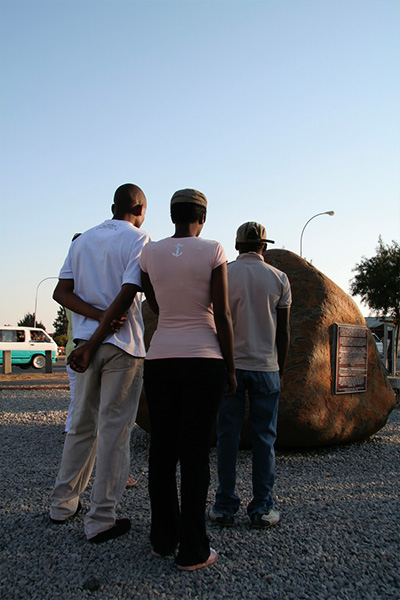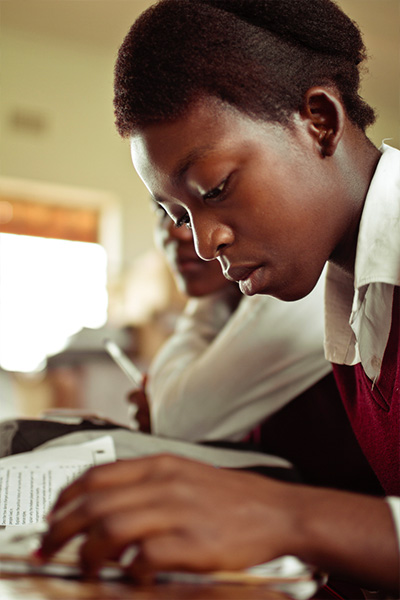

Western generational concepts don't apply in South Africa
 Does the classification of Gen Z, Millennials, Gen X and Boomers work in South Africa? Are other terms or categorisations used in SA?
Does the classification of Gen Z, Millennials, Gen X and Boomers work in South Africa? Are other terms or categorisations used in SA?
 It’s very difficult to use these terms without adding in “ifs” and “buts”, as our landscape is very much split into two – pre- and post-apartheid. We do not have the luxury to speak of the global classifications as not enough time has passed. Many of the issues of race, lineage, culture, and inequality still stand.
It’s very difficult to use these terms without adding in “ifs” and “buts”, as our landscape is very much split into two – pre- and post-apartheid. We do not have the luxury to speak of the global classifications as not enough time has passed. Many of the issues of race, lineage, culture, and inequality still stand.
However, the generation born from 1994 onwards (roughly overlapping with Gen Z) are known as the “Born Frees” and they grow up in a very different country.
The concepts of “Millennials” and “Boomers” are Western constructs that might not necessarily apply to a country like South Africa. Our South African “Boomers”, for instance, lived a very contrasting life compared to their American counterparts. The post-WWII US Boomers experienced freedoms and growth, while SA Boomers witnessed the introduction of Apartheid and a boom in racialised inequality, but also economic growth and more industrialisation.
 To what extent and where can we see more similarities within generations than between generations?
To what extent and where can we see more similarities within generations than between generations?
Everyone is aspiring to great things and the strive for instant gratification is real, no matter what your race or ethnicity or age. More than ever, young folk are becoming global thinkers and global citizens, and are looking to global thought leadership, whilst supporting local brands, food and customs. There is a great sense of pride in local – particularly young, black and thriving.
However, there will always be similarities between generations too – the concept of the “black tax” is real. No black boy/girl/man/woman who is out of school and working is exempt from it, making it feel like baggage from the past that one just cannot escape
 To what extent and where can we see more differences within generations than between generations?
To what extent and where can we see more differences within generations than between generations?
 Again history plays a role here. Within the Born Free generation, access to opportunities might be more equal now, but very few black people can speak of generational wealth, or the hope of inheriting it – apartheid did not allow for it. Within the generation, they might be aspiring for the same things, but more often than not, a young black person will have a few more hurdles to clear than a white person before they get there.
Again history plays a role here. Within the Born Free generation, access to opportunities might be more equal now, but very few black people can speak of generational wealth, or the hope of inheriting it – apartheid did not allow for it. Within the generation, they might be aspiring for the same things, but more often than not, a young black person will have a few more hurdles to clear than a white person before they get there.
There are also educational differences. As of 2020, 15% of 25–34 year-olds had a tertiary qualification whereas 46% had left school without an upper secondary qualification. As a result, the employment rate for those with a tertiary education was 29pp higher than among those with below upper secondary attainment.
This opens a whole other can of worms:
- Our government education system does not produce people who are fit for employment after 12 years of education. (This is the very short answer.)
- Currently you can pass matric (grade 12) with an average of 30% - this is not inspiring academic prowess and everyone who can afford it, black and white, put their children into private schools – which offer a high international standard of education.
- It is logical that those with lower academic qualifications (your example above) will find it more difficult to find work. This is then feeding a vicious downward spiral, i.e., people do not find work, so they stop looking for work or trying to improve their qualifications.
- Many South Africans believe that education is more important for a boy than a girl. For many years now, girls have outperformed boys (on average) in matric. However, first year university students are more male than female, but if you look at the figures after three years, more females graduate with a Baccalaureus degree after three years than males. They might take two or so years longer, or they leave university altogether. Largely driven by the cultural bias that male children are the ones who will grow up to change and rule the world, thus deserving of all the financial investment towards their education.
 Does the cohort effect play a role between those who grew up during Apartheid vs those who grew up after Apartheid?
Does the cohort effect play a role between those who grew up during Apartheid vs those who grew up after Apartheid?
 It is important to understand the effect of 1994 (the first election in which all South Africans, 18 years and older, could vote took place on 27 April 1994) – children born thereafter (the Born Free) have a different outlook to those that were born and lived through apartheid. Though cultural expectations are things that change extremely slowly, they are having to be managed very differently. An example is parenting Born Frees without bringing in the effects of the PTSD caused by apartheid.
It is important to understand the effect of 1994 (the first election in which all South Africans, 18 years and older, could vote took place on 27 April 1994) – children born thereafter (the Born Free) have a different outlook to those that were born and lived through apartheid. Though cultural expectations are things that change extremely slowly, they are having to be managed very differently. An example is parenting Born Frees without bringing in the effects of the PTSD caused by apartheid.
I think it is important to remember that the change from Apartheid to Democracy in South Africa was revolutionary – but that it was a process and did not take place on one auspicious day. Some (small) changes to the constitution happened during the 1980s, there were organisations like the UDF, who negotiated regularly with government, there were several discussions with the ANC in exile.
Change was inevitable.
In 1990 Nelson Mandela and other struggle leaders were freed from prison and all political parties were unbanned. The years 1990-1994 were tumultuous, and rapid progress were made – there were also knife-edge moments, like when Chris Hani (the leader of the SA Communist Party) was murdered and the ANC and the IFP had an internecine war raging for four years.
So yes, I think there is a difference between the kids who grew up during the 1980s and during the 1990s. Post-Apartheid kids are more sure of themselves, they know what they want, they care more for the environment and they see all people as the same. All of them are not necessarily colourblind, but some of them definitely are, they know there are opportunities for them in the wider world. They also have a stronger sense of community and that things should be achieved together.
Kids born during the 1980s are less sure of themselves, but they are tough – they grew up during a difficult decade for both blacks and whites in the country. I think they are more individual-minded, they had to work hard for things they got.
First year university students are more male than female, but if you look at the figures after three years, more females graduate with a Baccalaureus degree after three years than males.
 What is/was the impact of Covid?
What is/was the impact of Covid?
Many social issues were brought to the surface by Covid. The escalation of gender-based violence (GBV), isolation and deep poverty, amongst people of all population groups. At the same time, Covid was a leveller, no matter your skin colour or social standing – lives and livelihoods were lost across the spectrum – grief was universal, and the isolation was felt nationwide. Covid showed that issues such as depression have no colour or class. The chasm was highlighted in terms of access to medical care, so too was the fact that some of our best medical professionals are to be found in the underserved public health system of our country.
South African doctors, whether they work in the private or in the state sector are generally excellent and very well qualified. Like doctors all over the world, they work horrendous hours, as there are simply not enough of them. The doctors in the state sector generally work even longer hours. The private sector hospitals are only available to people who have a medical aid – generally people who are working.
During Covid, the doctors and nurses in the state sector carried an uneven burden – there were many more patients needing their help than Covid patients in the private sector. In the private sector the equipment is newer, better maintained and generally more available – in the state sector, it is not the case. You use what you’ve got and make a plan Covid also had a significant effect on life expectancy. From 2020 to 2021, life expectancy at birth for males declined from 62.3 years to 59.2 (3.1-year drop), and 68.4 to 64.2 years (4.2-year drop) for females. After the 2021- 22 vaccine rollout, life expectancy at birth improved by 0.8 years for males (60.0 years) and 1.4 years for females (65.6 years).
Covid brought about the same uncertainties for everyone, particularly the mistrust of politicians or political parties grew, which led to people across the spectrum coming closer together.
 The fertility rate is now close to replacement ratio – is the country preparing for a population that is no longer growing?
The fertility rate is now close to replacement ratio – is the country preparing for a population that is no longer growing?
 Unfortunately, as with many things in South Africa, there is very little planning for the future. As an example, the Department of Education in Gauteng (the smallest, but most populous province where both Johannesburg and Pretoria are situated) had to double the number of classrooms in some areas in a space of about two weeks at the beginning of this year, because they did not plan for the number of children who were starting school (either primary school or high school). As a quick fix, they put up temporary classrooms – but there are no plans to make these permanent or to actively recruit young people to be teachers.
Unfortunately, as with many things in South Africa, there is very little planning for the future. As an example, the Department of Education in Gauteng (the smallest, but most populous province where both Johannesburg and Pretoria are situated) had to double the number of classrooms in some areas in a space of about two weeks at the beginning of this year, because they did not plan for the number of children who were starting school (either primary school or high school). As a quick fix, they put up temporary classrooms – but there are no plans to make these permanent or to actively recruit young people to be teachers.
There also is no planning to make provisions for an older population in the future. Economists express their worry about the low level of savings and contributions to a pension fund.
Additionally, it is important to note that in the post-Apartheid era since 2008, the population growth rate has exceeded the economic growth rate, which is mounting pressure on a country struggling with economic woes.
Like doctors all over the world, they work horrendous hours, as there are simply not enough of them. The doctors in the state sector generally work even longer hours.
 What is there to say about urban vs rural demographics? And what is there to look out for next?
What is there to say about urban vs rural demographics? And what is there to look out for next?
Firstly, it’s important to understand that SA is the fifth most populous African country, yet its demographic features resemble that of a developing country. The population growth rate in rural areas is higher than in urban areas and women tend to have a first baby earlier in life in rural areas than in urban areas. People in rural areas also tend to be on average older than those in urban areas (on the macro-level) - and the population sex split in rural areas is more female than male. This is probably a remnant of the labour system practices during apartheid, when men could not take their families with them when they found a job at a mine or other big corporations in a city.
Although there are many, many poor South Africans living in the eight metropolitan areas and cities in the country, we also see a lot of poverty in rural areas. Limpopo Province is 79% rural with no major metro areas, and probably one of the poorest provinces in South Africa.
The Eastern Cape is 49% rural, and while it contains two Metro areas for job seekers, work opportunities are probably much better in the Western Cape which is a much richer province – therefore, there’s a steady stream of internal migration of hopeful jobseekers from the Eastern to the Western Cape.
Despite these large rural communities, investment in infrastructure, education, health, work opportunities and income-earning opportunities are not equally distributed between metropolitan and rural areas, potentially leading to resentment and division in communities.
Urbanisation leads to more opportunities, less children per household, and the raising of the education standard (especially of girls) - but there are many other challenges. – in terms of infrastructure and service delivery in urban areas.
 What are the myths vs reality that you would focus on for someone outside South Africa?
What are the myths vs reality that you would focus on for someone outside South Africa?
Reality: many children of all races grow up with a single mother and without a father present in the household.
Urbanisation leads to more opportunities, less children per household, and the raising of the education standard (especially of girls) - but there are many other challenges. – in terms of infrastructure and service delivery in urban areas.
There is a myth that all white people are rich, and all black people are poor – this is not the case and both population groups are spread across all income groups in the country. Having said that, the spread is not equal though – so feeding into the myth perhaps. As much as things have opened up, previously disadvantaged, means having a lot of catching up to do before we can get to a semblance of equality.
Table of content
- We need to talk about generations: Understanding generations - Foreword by Ben Page
- Introduction: Generation myths and demographic realities
- Context: Why generational analysis matters
- Peak population: Preparing for the fall
- A topic of conversation: How do people talk about generations?
- Generation questions: Issues to think about
- How to tell a myth from a reality in UK generations
- Western generational concepts don't apply in South Africa
- Why where you live matters in understanding generations in India
- Super-ageing in post-pandemic South Korea
- Population bust: How Italy is finally facing its grey rhino
- Mexico: from a teenage country to an adult one in a century
| Previous | Next |

![[Webinar] KEYS: THE MIDDLE CLASS: In Crisis?](/sites/default/files/styles/list_item_image/public/ct/event/2025-10/middle-class-family-dinner-food-carousel.webp?itok=iD1QyX8n)
![[Webinar] KEYS: Global Trends - The Uneasy Decade](/sites/default/files/styles/list_item_image/public/2025-09/image/minisite/keys0925.png?itok=3oAiYcxm)
